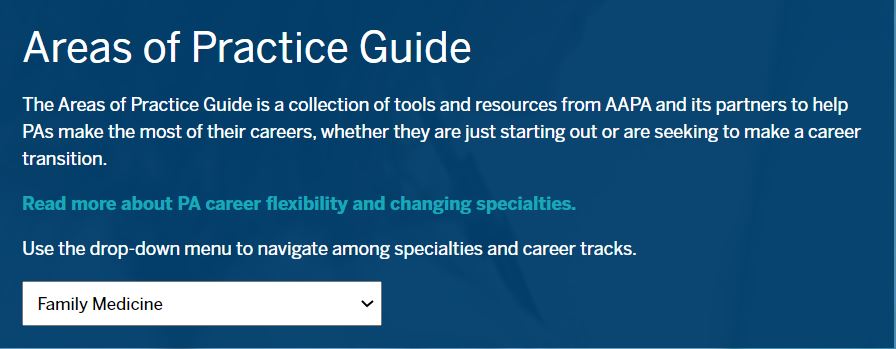5 Things PAs Need to Know about the New Areas of Practice Guide
A New Resource Created Just for You!
May 4, 2021
 At AAPA, we’re always looking for new ways to help you in your career. Career flexibility is one of the most often-cited reasons PAs choose the profession. We know you are hungry for information about the specialties and modes of practice that are open to you.
At AAPA, we’re always looking for new ways to help you in your career. Career flexibility is one of the most often-cited reasons PAs choose the profession. We know you are hungry for information about the specialties and modes of practice that are open to you.
[Want more FREE career resources from the experts at AAPA? Become a member today!]
In the interest of saving you time and connecting you with the resources, data, and insider tips that you need to learn about the specialties and modes of practice that interest you, we’ve created the AAPA Areas of Practice Guide. Kelsey King, AAPA’s assistant director of Career Products & Services, has been working on the Areas of Practice Guide for months and is excited to unveil this comprehensive resource. She shares the five things she thinks you’ll find most useful about the Areas of Practice Guide.
Join AAPA for unparalleled career support
- Everything you want to know, located in one place.
The Areas of Practice Guide is intended to be a one-stop shop for PAs who are looking for information about different PA specialties or modes of practice. Do you want to know the salary difference between two specialties? Go to the Areas of Practice Guide! Are you not exactly sure what a specialty might encompass in its entirety? Check out each specialty’s overview section. Additionally, you’ll find CME information, helpful specialty-specific resources, and even job listings.
- The Areas of Practice Guide is made for PAs at all career stages.
The Areas of Practice Guide is helpful wherever you are in your career. If you’re approaching graduation from PA school, you can use the Areas of Practice Guide to compare specialties. How many PAs practice it? How much will you make? What jobs are available? If you’re a seasoned PA who’s happy at work, you can use the Areas of Practice Guide to build your professional network and stay current on your CME. And if you’re in the middle of your career and interested in changing specialties, you can compare and contrast – all in one place – and determine which next career move is right for you.
- Read insider details from your PA colleagues.
We know that your peers are your most trusted sources of PA-related information. So don’t take it from us, take it from them! The Areas of Practice Guide includes a “Words from the Field” section, where PAs who practice in each specialty share their insider information and insights with you. “Words from the Field” may help you get a better sense of what day-to-day practice is like, why your colleagues find the specialty rewarding, or even some of the challenges they face at work. It’s a peek behind the scenes at each of the specialties and modes of practice featured, and it will give you a real sense of what it might be like to practice in that specialty.
- The Areas of Practice Guide will be regularly updated.
You know how much PA practice can change from year to year, from state to state. The Areas of Practice Guide will be updated regularly so that you can avoid checking multiple sites and news outlets for up-to-date information. Whether you’re looking for salary numbers or state laws and regulations that effect your practice, find the latest information in the Areas of Practice Guide.
- There’s more to come!
PAs practice in every medical setting and specialty, and the Areas of Practice Guide will continue to be developed to meet your needs. Keep an eye out for additional specialties and modes of practice to be added, as well as additional helpful tools and resources (like upcoming CME!).
Check out AAPA’s new Areas of Practice Guide, and tell us what you think!
You May Also Like
Areas of Practice Guide
Salary Report
Career Central
Thank you for reading AAPA’s News Central
You have 2 articles left this month. Create a free account to read more stories, or become a member for more access to exclusive benefits! Already have an account? Log in.



